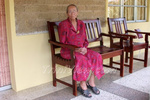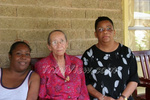TriniView.com Staff Article
December 16, 2005
While we journeyed through Lopinot covering the Lopinot Heritage Festival we interviewed two of the residents to get some first-hand information about the history of the village. Ninety-seven year old Lucy Dolabaille Alexis Guerrero gave us bit of her own personal history. This is her story...

Lucy Dolabaille Alexis Guerrero
|
I am Lucy Dolabaille Alexis Guerrero and I am ninety-seven years old. I was born in a place called Caraquita, which is a little higher up La Pastora. My brother Phillip Ellis Dolabaille and I were born on an estate up there and my father was an overseer on the same estate.
My brother was born in 1907 and I was born in 1908.
Life on the estate was wonderful and everybody lived as one.
I used to do a lot of things as a child growing up. When I was about six or seven years old I took music lessons, then later on I joined in the choir and I played the organ. At the time when I got involved in music there was a lady who played the organ and she encouraged me to play. I was married twice, the first time I was about twenty-four years old. I was a 'Dolabaille' before I got married to my first husband; he was Emanuel Michael (Mark) Alexis who was a Mathematics Teacher. At that time he taught with his uncles at Pamphilian a recognized Private Secondary School in Port of Spain. That was the first private secondary school in Trinidad and his uncle Ethelbert Alexis was the Founder and Principal. Mark was an efficient Mathematics Teacher, most of his students excelled in the subject. He used our home at Cadez Road, Belmont to train his students who needed extra tuition all for gratis and enjoyed imparting his knowledge to the students. Mark attended St. Mary's College (CIC) where he was taught Mathematics by Father English who marvelled at his brilliance and how he found methods to simplify the subject. Fr. English allowed him to conduct the Mathematics Classes while he looked on in awe. His father was Athanatius Sylvin Alexis who was Head Teacher of Maracas Government School and taught at that school for over forty (40) years. His mother was Benigna Catalina Lezama Alexis.
I first met Mark at a concert in the Caura valley where I lived and taught. My brother Victor Dolabaille also taught at the same La Veronica RC school. Mark's uncle Edwin Alexis was the Head Teacher then and he invited him to the concert at the school. I was a soloist at the concert, I sang a Spanish song and played the organ on that day. It was at that point in time that my husband Mark fell in love with me.
I cannot remember how old I was when I got married the second time to Sylvester Guerrero. I had seven children in my first marriage, six girls and the last child was a boy. All my children are alive but both my husbands are deceased. After the death of my first husband I came back to live in Lopinot.
Nola Alexis Stanley, the daughter of Lucy Dolabaille Alexis Guerrero offered to expand on the history of her life in Lopinot and a bit about the culture of the villagers there.

RIGHT: Nola Alexis Stanley
|
At present I live at Arouca but lived in Lopinot while I attended secondary school. My sisters and I resided with relatives during the week and returned to Lopinot on weekends. We attended St. Rose's Girls' Intermediate School on Henry Street, Port of Spain.
There is a difference living here in Lopinot and living out of Lopinot. In Lopinot there is a family like setting, you feel closer to the villagers and more at home, you really belong. Lopinot is "home" even at this present time. It is a place where everyone knows you and you are very much involved in the activities of the village. The folks visit you all the time. If someone dies or if anyone is ill the village supports you, that's our culture. Away from Lopinot it's quite different everyone is busy, occupied with personal affairs sometimes oblivious of what is happening in their immediate environment.
I enjoy living both in and out of Lopinot, there are advantages. One of the advantages living away from here is the easy access to transportation. It is difficult at times getting in and out of the village. One has to time the taxis especially when attending courses, functions etc. or hope that someone will come along and offer to take you to your destination.
The main attraction is the Complex across the road which is called the Lopinot Historical Site. As a child I knew it to be the estate of Count de Lopinot, who was originally from France, he lived and died on the plantation with his wife and slaves. My sisters, brother, cousins, neighbours and I played there a lot. The house on the compound was referred to as "The Big House" I remember there was a deep pool in the river at the back of the Count's house and the neighbourhood children dived into the river from the bank. That's where we enjoyed a good river bath. I also recall the older folks saying that the Count used "the cashew tree" which stood on the grounds as a "hanging tree" for the slaves and imprisoned them underneath the cocoa house. It is believed that was the method he used to punish the slaves.
"The Cocoa Houses" situated at the Complex were used by some villages to dry their cocoa and coffee crops. Many folks were also accommodated under the cocoa houses free of charge when they were relocated to Lopinot in order for the then Government to construct a dam in the Caura valley to supply water to certain parts of Trinidad. The Cocoa Houses have many memories. There was also another house on the grounds close to "the cashew tree" which housed many families until they acquired their own property. I loved seeing them dance the cocoa which was part of the preparation before the actual bagging and sale at Crawford Marr on Duncan Street, Port of Spain. The process of cocoa before sale – (Pick, crack, clean, sweat, spread out in a cocoa house for sunlight and shelter from rain, dance, and shine then package). In those days cocoa was considered "king" (a prosperous crop) The Christmas harvest was most welcomed particularly when proprietors enjoyed "Cocoa Pool" returns from the Cocoa Board at the end every year, earning them extra cash at Christmas time. The tradition of using the cocoa houses on the compound probably stopped about thirty years ago.
The culture in Lopinot is different now because almost everyone works out of the village. Some people may still follow the tradition but I do not know how many people may still sell cocoa and coffee because I am not in the area especially during the week. I know that the folks have moved on in life, they did well, are very successful in their endeavours, work all over the island and are educated. Agriculture still exists in
the area but not as it was in my childhood days.
In my era there were means of transport in and out of the valley, but not regularly. We lived at relatives to attend schools. In our family we were accommodated at out uncle's in Mt. Hope (Gabriel Alexis) and aunt's in Barataria (Petrucia Alexis-Lue Sue) and returned "home" on weekends. Our grandparents (Louis Bobb Dolabaille and Julia Ruiz-Dolabaille) arranged with a special driver to have us transported back to school and work on Monday mornings. While away from "home" we anticipated Friday evenings when those of us at school will return to Lopinot while the others who worked returned on Saturday evenings. The road then was almost like it is today rough, winding and broken edges. In my early childhood days it was a very narrow path, drivers of vehicles had to reverse or seek a spot to wait until it was secure enough for another vehicle on the opposite side of the road to proceed. I can also call to mind the days when it was a stone road and later on pitched which made life easier for commuters.
In the early days the Parang Tradition was very enjoyable. There were paranderos like Sotero Gomez, Pedro Segundo Dolabaille (Papa Goon), Christopher Reyes, Luciano Reyes, (Sylvester Guerrero who introduced many of his friends to parang and took parang to urban areas) the families were: Salina, Garcia, Castillo, Guerrero, Hernandez, Ruiz, Guevara, Norega to name a few. In those days all Paranderos visited our home to serenade our grandparents, "Ma Babb and Mr. Babb" as they were called. Granny and Grandpa welcomed the entertainment and looked forward to their visits. I can bring to mind an occasion when the school's Principal announced to the school that there would be parang music for the School Fair (Frolic), and the response from the school children was "No!"
As we grew older we understood and appreciated our local music more. There was parang music at Christenings, Weddings and on other occasions where villagers danced "Castillian", "Pasio", "Galleron", "Tango" and other dances. We really had good times on those occasions.
My Grandfather Louis Bobb Dolabaille (Mr. Babb) owned the Caraquite Estate where my mother was born. There were others estates - San Jose, Castillo, and El Socorro. Some of the estates were sold and others passed on to relatives. Right now we need proper roads, a health centre and sporting facilities for the youths. There is water in the pipes all the time, but the water gets brown when it rains. I live at Arouca and at this present moment there isn't any water in the pipes (laughter). The folks are fortunate in Lopinot because there is water flowing in the pipes at all times.
For more information about Lopinot see:
A Brief History of Lopinot
Savoring Lopinot
Lopinot in pictures:
www.triniview.com/gallery/main.php?g2_itemId=132838
Also Read:
North-West Communities: Lopinot
The Count Loppinot
Homepage | Lopinot | Special Events | Photo Gallery
|
